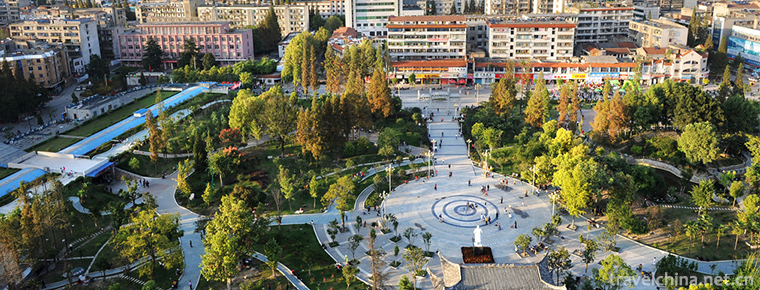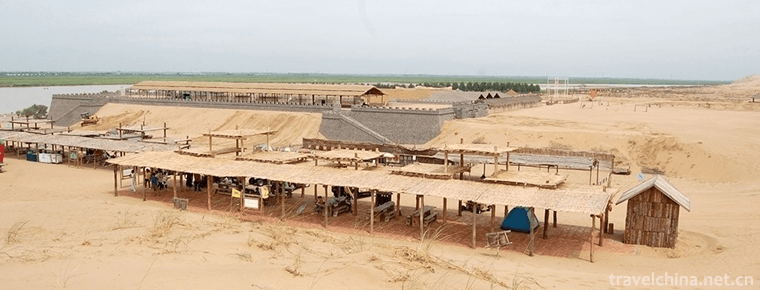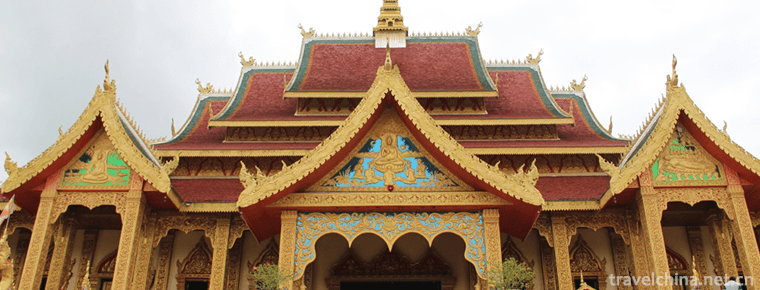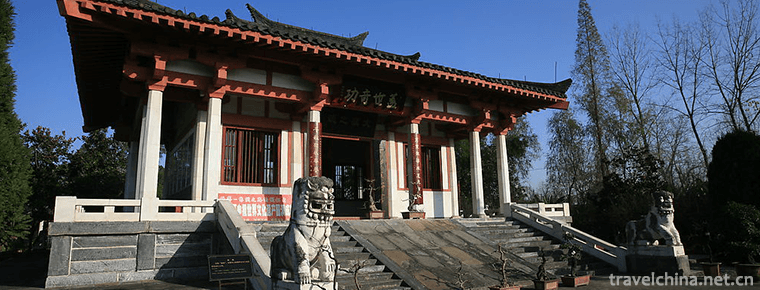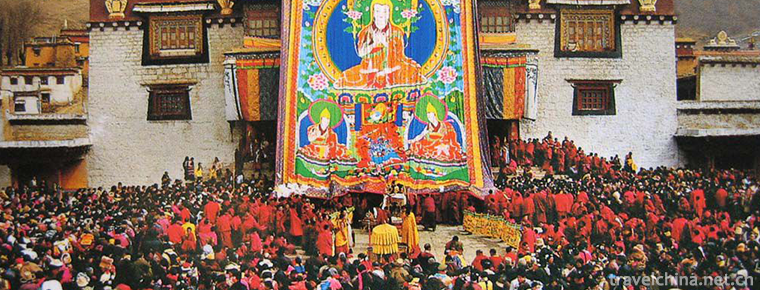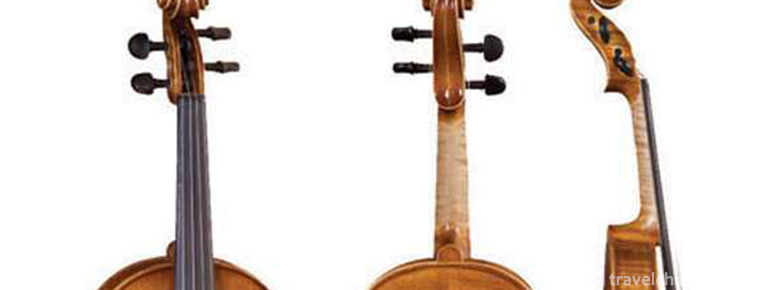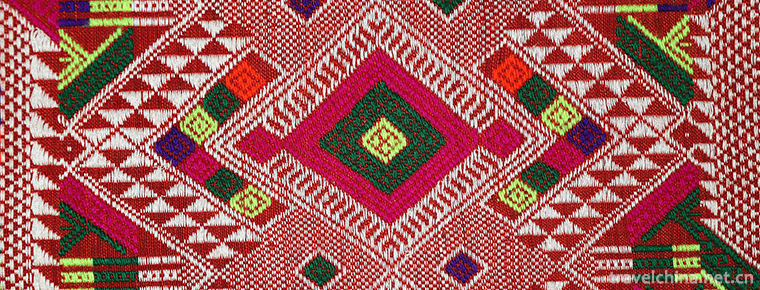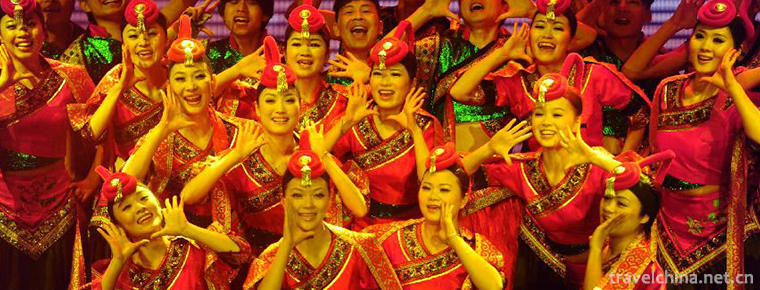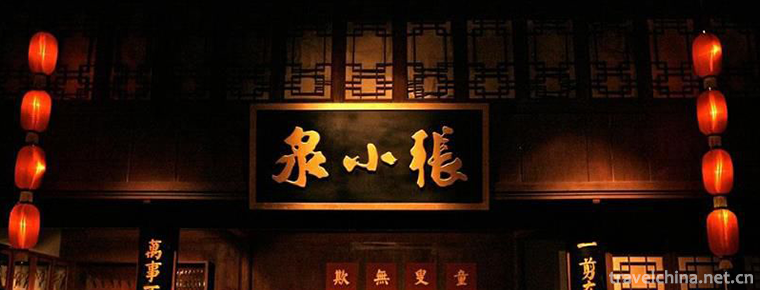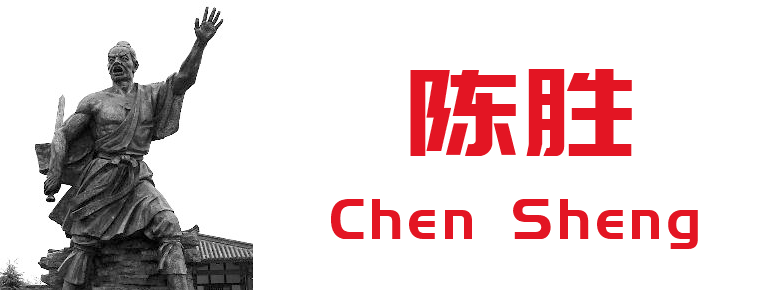Maiji Mountain Scenic Spot
Maiji Mountain, located in Maiji District of Tianshui City, Gansu Province, is a lone peak of Xiaolongshan, 142 meters high, named for its resemblance to wheat stacks. Maijishan Grottoes were built from 384 to 417. There are 221 caves, 10632 mudstone sculptures and more than 1300 square meters of murals. They are known as the exhibition hall of Oriental Sculpture art.
Maijishan Scenic Area is composed of Maijishan, Xianrenya, Shimen, Quxi and Jieting Hot Springs, which are more than 180 scenic spots. It has rich and diverse biological types and species. It is called "the crown of Longshang Forest Springs". It has profound tourism value and is a dazzling artistic pearl and the most potential tourist attraction on the golden tourism line of Silk Ancient Road.
Maijishan Grottoes: World Cultural Heritage, National AAAAA Tourist Scenic Spot, National Key Scenic Spot, National Forest Park, National Geopark, National Key Cultural Relics Protection Unit, one of the four major Grottoes in China. In the 2008 Northwest China Tourism Marketing Conference and Tourism Equipment Exhibition, it was included in the "Magic Northwest 100 Sceneries" list.
geographical environment
After large-scale reinforcement and repair of Maiji Mountain, the crumbling cliff body has stabilized, the mountain trestle road is wide and orderly, safe and reliable, and the vicious scenes described by Wang Renyu in the past have long become history. People can safely and boldly climb the cliff pavilions, enter the caves at will, and view the beautiful scenery under the mountains with unrestrained feelings.
Maiji Mountain is 142 meters high. Grottoes are mostly cut into cliffs 20 to 70 meters high. There are cliff pavilions, grottoes, cliff niches, mountain towers and corridors. The grottoes are shaped like a herringbone crest, a collapsed four-sided crest, an arch lintel, a dome, a square lintel flat top, a square flat top, a circular small shallow niche and a pelvic top. These different types of niches and cliff pavilions are material materials for the study of cultural exchanges between China and the West and the evolution and development of architectural structures. According to records, when the grottoes were excavated, timber was accumulated from the bottom to the top, and then constructed to build a layer. The timber was demolished one layer until the foot of the mountain. Legend has it that when Li Yunxin built the Seven Buddhist Pavilions for his dead father, he used 400,000 manpower. Up to now, there are also folk songs: "Cut down Nanshan firewood and build wheat cliffs", "First there are ten thousand Zhang firewood, then there are wheat cliffs". Even the first American tourists praised the Maijishan Grottoes as "one of the seven largest projects in the world" in the 1947 Peace Daily. Maiji Grottoes was originally a complete mountain body. In the 22nd year of Kaiyuan in Tang Dynasty, a strong earthquake occurred in Tianshui area, which caused the middle part of the cliff surface to collapse. The whole grotto group was divided into two parts, the East Cliff and the West cliff. There are 54 caves in Dongya and 140 caves in Xiya. Because Maijishan stone is purple-brown hydrogenic mother rock, it is not suitable for fine carving, so clay sculpture and painting are mostly used. The main themes of Maijishan statues are Buddha, Bodhisattva, disciples, King of Heaven and Rexroth. Although the statues of different generations coexist, they do not imitate, but maintain their own characteristics of the times, which systematically reflects the development and evolution of clay sculpture art in China. Whether it is a giant statue as high as 15 meters or a small statue as high as 0.3 meters, it gives people a sense of beauty. After visiting the statue of Mt. Maiji, Soviet sculptor Nie Klingduhoff said excitedly, "The sculptures of the Northern Wei and Song Dynasties are the most fascinating to me. They have amazing inner world, expressive composition and magnificent form. There are thousands of statues of Maijishan. Here we can only point out several representative masterpieces, which play the role of "seeing a spot and knowing the whole leopard". The most magnificent statue of Dongya is the seven Buddhist pavilions on Cave 4. There are 42 statues of Bodhisattvas in the seven Buddhist shrines. They have a solemn and amiable manner, are beautiful and not vulgar, and are full of human kindness, kindness and secular feelings. Each niche is decorated with eight floating sculptures of the dragon, with a grim but not ugly face, showing the male's bodybuilding, dignity, integrity, courage and perseverance. Cave 5, which is close to Shangqi Buddhist Pavilion, is called Niu Ertang. In front of the middle niche door stood a calf lying on its back. The bull is very moving: round eyes, naughty gaze at the foreword, feet curling, but it seems to jump up, the skin hanging from the loose neck, also like moving. Not only does the body and posture have the characteristics of cattle, but the most outstanding is to show the childishness and liveliness of a calf. Local farmers are very fond of it, which is called "the bull doll with golden feet and silver horns". At the west end of Niu Er Tang, there is a tunnel about 10 meters long, with four words inscribed on the top of the door: "There is a small cave in the sky". Legend has it that on the eighth day of April in the ancient calendar of the Ming Dynasty, there was a state official in Qinzhou who visited the Maiji Mountain Temple Fair. On the spur of the moment, he wandered from the ferry chain of the Seven Buddhist Pavilions to the Niu'er Hall with the jumping posture of a kite turning over. But when he stood firm in Niuer Hall and looked down, he saw that the cliff was steep and the crowd in the valley was like ants. He was dizzy and his legs were shaking. He dared not walk any more. All the officials had to rush in a group of masons to dig a small hole, and the state officials just climbed up from the hole. So far, there is still a local saying that "Harrier turns over, Niu Ertang".
There are also several fascinating scenic spots around Mt. Maiji. For example, the Diao Chaoyu Valley under the three cliffs of the back cliff of Maiji Mountain was the refuge palace of the Xizhou General in the late Western Han Dynasty. At that year's summer resort, pavilions and pavilions scattered, winding corridors connected, glazed green tiles Xiecui, red walls Jinlong Ying, three eaves four clusters of carved phoenix, flowers and shadows green bamboo, silver practice Zhulu splash. With the passage of time, the golden and green summer resort has long disappeared. Only three waterfalls, ancient cypress pines, rocky rocks, fantastic flowers and grass, rare birds and beasts still exist under the cliffs, which are about 40 meters high.
Maijishan, also known as Maijiya, is located in the south of Maijishan Township, 50 kilometers southeast of Tianshui City, Gansu Province. It is an isolated peak in the Xiaolongshan system of the Western Qinling Mountains. Maijishan Grottoes were founded in the late Qin Dynasty (384-417 A.D.) of the Sixteen Kingdoms and then repaired and expanded frequently. They were basically completed in the Sui Dynasty at the end of the sixth century A.D. and remain intact until now. The area is surrounded by mountains of pine and bamboo, surrounded by peaks, and Maijiyixiu rises. It was called "the crown of the forest and Zhu in Qin Dynasty" in ancient times. It is a peculiar peak in Xiaolong Mountain at the western end of Qinling Mountains in China. It is 1742 meters above sea level and 30 kilometers away from Tianshui Railway Station. Maijishan Mountain is 142 meters high and has a peculiar shape. Its solitary peak rises like a wheat stack. It is called Maijishan Mountain because it crosses the Qingwei River in the north and gradually goes south, with 500 miles of hills and hills in the south. To the southwest of the mountain is a cliff. Maijishan Grottoes were excavated on this cliff. Some are only 20 meters away from the base of the mountain, and some are as high as 80 meters. It is rare in Chinese Grottoes to dig hundreds of caves and Buddhist statues on such steep cliffs.
Maijishan Scenic Area covers an area of 215 square kilometers, including Maijishan, Xianrenya, Shimen, Quxi and Jieting Ancient Town. Maijishan Grottoes are one of the four major Grottoes in China. The other three grottoes are Dunhuang Mogao Grottoes, Longmen Grottoes and Yungang Grottoes. Maijishan Grottoes is a national key cultural relic protection unit, and also a world-renowned art treasure house, with the reputation of "Oriental Sculpture Museum".
On December 15, 2010, the National Tourism Administration officially approved Maijishan Scenic Spot as a national 5A tourist attraction.
Maijishan is commonly known as Maijiya. In Yutang Gossip, written by Wang Renyu, a man of Tianshui in the Five Dynasties, it is said that "Maijishan people, who cross the Qing Wei River in the north, gradually go south and south, have five hundred miles of hills and ridges, half of which are Maijie areas, rise to a rock, high million heights, and hope of the regiment, such as folk wheat accumulation, so it has this name." The image shows the reason why Maijishan got its name. Maijishan scenic area is full of pines and bamboos, with clear streams all over the country and green mountains. It has been known as "the crown of forest springs in Qin Dynasty" since ancient times. Spring is green, summer is full of mountain flowers, autumn white clouds and red leaves, winter is full of Yushu Qiongzhi, quite a four-season scenery of the South. "Maiji Smoke and Rain" is one of the ten sceneries in Qinzhou. The beautiful scenery like immortality intoxicates visitors. Wu Xichuan, a native of Linyi in the Qing Dynasty, praised in his poem "Mai Jiyu Yanyu" that "after the most suitable autumn rain, he loves the smoke at dusk". It can be seen that the smoke and rain stir people up. Up to Majishan Grottoes, "scattered flower tower" overlooks the vast sea of hundreds of miles, such as picturesque poetry, full of green eyes, momentum. If the colorful petals are scattered in the air and the air is blowing upward, there will be a charming scene like "divorced flowers of the goddess", which makes people feel fluttering and immortal. Maijishan Grottoes is the main tourist spot of Maijishan Scenic Spot. It is excavated on the cliff cliff wall 80 meters away from the ground. The caves are "as close as beehives" and the trestles are "flying through the clouds", which are rare in the world. Du Fu said in a poem, "There are few remnant monks in the wild temple, and the narrow paths are high. Musk sleeping carnation, parrot pecking golden peach. Chaotic waters pass by and cliffs lie in prisons. Over the cabinet late, a hundred miles see the autumn. With the opening of the Silk Road, Maijishan Grottoes were built in the post-Qin period (384-417 A.D.) of the Sixteen Kingdoms. The proverb says, "Cut down all the firewood in Nanshan and pile up the wheat cliff." It can be seen that the construction work is huge and arduous. According to Liang's Biography of Eminent Monks, during the Southern Dynasty and Song Dynasty, the eminent monk Xinhong Chan lived in Maiji Mountain. Not long after, the eminent monk Xuan Gao came to live in a temple with more than 300 apprentices. It is known that Buddhist affairs were flourishing at that time. When the Western Wei Dynasty had just established its emperor, it was here to "build cliff pavilions and revitalize temples". Emperor Wei Wendi wore hair and practiced with Empress Yifu here. After his death, Emperor Wei Wendi "chiseled wheat cliffs and buried them for niches". During the period of Baoding and Tianhe in the Northern Zhou Dynasty, Li Yunxin, the governor of Qinzhou, built the Seven Buddhist Pavilions for his deceased father. Yu Xin, a great poet, wrote an inscription on Maiji Cliff Buddha's niche in Tianshui County, Qinzhou. In the second year of Renshou, Emperor Wendi of the Sui Dynasty, when Yang Jian buried "God Nissaili" in the whole country, the envoy of Qinzhou buried him on the top of Maiji Mountain, where the Sui Dynasty's Shrine Tower stood tall at 9.4 meters. Tang, Five Dynasties, Song, Yuan, Ming and Qing dynasties have been chiseling or rebuilding ceaselessly. Despite the destruction of many earthquakes and fires in history, 194 caves, more than 7,800 clay and stone statues and more than 1,000 square meters of murals are still preserved, which is one of the four major Grottoes in China.
topographic features
Maijishan is a typical Danxia landform. Its stone is purple-brown hydrogenetic rock. Its mountain topography suddenly rises to a single peak. At first, there were many natural caves. Its elevation is 1742 meters, and the top of the mountain is 142 meters above the ground. In the late Western Han Dynasty, Maijishan Mountain became a summer resort for famous generals in Tianshui. There are more than 200 statues of the late Qin, Western Qin, Northern Wei, Northern Zhou, Sui, Tang, Five Dynasties, Song, Yuan, Ming and Qing dynasties, with more than 1,300 square meters of murals distributed in 194 caves. All the niches were excavated on the cliffs and distributed on the East and West cliffs. There are 54 caves in Dongya and 140 caves in Xiya. A total of more than 7200 clay sculptures, stone tires and murals, more than 1300 square meters. Most of the existing statues are original works of the Northern Dynasty (referring to the regime in the North during the Northern and Southern Dynasties).
Like the Mogao Grottoes in Dunhuang, Yungang Grottoes in Datong and Longmen Grottoes in Luoyang, there are precious artistic treasures. In terms of artistic features, Dunhuang focuses on gorgeous murals. Yungang and Longmen are famous for their magnificent stone carvings, while Maijishan is famous for its exquisite statues. As our sculptor Liu Kaiqu praised: Maijishan is "a large sculpture museum of our country in past dynasties."
Maiji Mountain potential
Maiji Grottoes, one of the four largest Grottoes in China, is a national AAAAA tourist attraction. Maijishan Grottoes is a national key cultural relic protection unit, and also a world-famous art treasure house. Maiji Mountain, located about 35 kilometers southeast of Tianshui City, Gansu Province, is a strange peak in Xiaolong Mountain at the western end of the Qinling Mountains in China. Its elevation is 1742 meters, but its height is only 142 meters above the ground. The shape of the mountain is peculiar, and its solitary peak protrudes like wheat pallets, so it is called Maiji Mountain.
Maiji Mountain is surrounded by beautiful scenery. The mountains are densely covered with green cypress, pines, wild flowers and grass. Climbing to the top of the mountain, looking far ahead, surrounded by lush green hills, only to see thousands of mountains, mountains overlapping, pine like the sea, clouds and mists, vision and near things intertwined, constituting a beautiful picture, which is known as the "wheat accumulated smoke and rain" of the top eight horizons of Tianshui. Among the famous Grottoes in China, Maiji Mountain is the best natural scenery. It is known as the "small south of the Yangtze River" and "the crown of forest and spring in Qin Dynasty".
Most scholars believe that it began in the post-Qin Dynasty and has been excavated and repaired continuously in the Northern Wei, Western Wei, Northern Zhou, Sui, Tang, Five Dynasties, Song, Yuan, Ming and Qing dynasties. Most of the existing statues are original works of the Northern Dynasty.
A prominent feature of Maijishan Grottoes is that the location of the Grottoes is extremely dangerous, most of them are excavated on cliffs, and the caves are accessible by overhead trestles erected on the cliffs. Tourists can't help but be thrilled to climb these winding overhead trestles. The ancients once praised these projects: "Between the cliffs, the stone becomes Buddha, and there are thousands of Grottoes in the niches. It's a divine feat to break it up from human resources. There is also a proverb among the people nearby: "Cut down Nanshan firewood and build wheat cliffs", "There are ten thousand Zhangs of firewood first, and then there are wheat cliffs". It can be seen that it was difficult and magnificent to dig caves and build trestles at that time.
Practical information
Ticket information
The ticket for visiting the caves is 90 yuan in Maijishan scenic spot, but 25 yuan for not visiting the caves. People over 60, PLA and students are half-price. Remember to bring old people's cards, ID cards, soldier's cards and student's cards.
Opening Hours
Summer: 8:30-17:30. Winter: 9:00-5:00.
Best travel time
July to October is the best. In late autumn, the red maple is full of mountains. If it encounters drizzling rainy days, we can see the rain and smoke of wheat, just like a fairyland on earth. In spring, Maiji Mountain is full of spring, rich in culture and scenery, and brilliant peach blossoms. In summer, there are many trees in Maiji Mountain, which is the best place for summer. In the off-season of winter, there are few people. Listen to the guide slowly and feel the beauty of the grottoes carefully.
Special reminder
Cameras and bags can be brought, but in order to protect cultural relics, it is better not to turn on the flash. As Maiji Mountain is a humanistic landscape, it is suggested that the tour guide explain it.
Traffic information
Internal traffic
1. In front of the Maiji District Railway Station, there is a special tour bus No. 34 to Maiji Mountain every day. The journey is about 40 minutes, every 20 minutes.
In Tianshui City, you can get off at Maijishan Parking Station, the terminal of Bus No. 5, and then you can get to Maijishan Scenic Spot. The fare is about 6 yuan.
2. After arriving at the gate of Maijishan scenic spot, you can walk for about 30 minutes (3 kilometers) to the grottoes, or take an interval bus, which costs 8 yuan per trip and 15 yuan per trip.
External traffic
Trains, cars, self-driving.
Main attractions
Maiji Grottoes niches are chiseled on vertical cliffs 20-80 meters high and 200 meters wide. There are 194 caves, including 54 caves in Dongya and 140 caves in Xiya. There are more than 7,800 clay sculptures, mud sculptures and stone sculptures. The largest one is 15.8 meters high and the murals are more than 1,000 square meters.
Grottoes were built in the post-Qin Dynasty (384-417), one of the four largest Grottoes in China, known as the "Oriental Sculpture Museum". If Dunhuang is a large fresco museum, then Maijishan is a large sculpture museum. The statues here are 16 meters in size and only 10 centimeters in size, reflecting the characteristics of statues of different times over the past thousand years, and systematically reflecting the development and evolution of Chinese clay sculpture art.














-
Zhongshan Park
Zhongshan Park is located in the south of the Forbidden City (Palace Museum) in the center of Beijing, west of Tian'anmen, and separated from the Palace Museum..
Views: 117 Time 2018-12-22 -
Huang Sha ancient ferry
The original eco-tourism scenic spot of Huangsha Gudu is one of the eight scenic spots of Ningxia in Ming and Qing Dynasties, including the national AAAA-level tourism scenic spot, the National Wetlan.
Views: 144 Time 2019-01-18 -
Xishuangbanna Mengwan Great Buddhist Temple
Situated in the suburbs of Jinghong City, the prefecture of Xishuangbanna Dai Autonomous Prefecture, Yunnan Province, the Monastery is built according to the national AAAA standard..
Views: 125 Time 2019-02-25 -
Tomb of Zhang Qian
Zhang Qian's tomb was the tomb of Zhang Qian, an outstanding diplomat, explorer and pioneer of the Silk Road in the Western Han Dynasty. In the third year of Emperor Yuanding of Han Dynasty (114 years.
Views: 241 Time 2019-03-16 -
Tibetan New Year
Tibetan calendar year is the traditional festival of the Tibetan people. Bhutan and Mongolia, which are deeply influenced by Tibetan culture, also celebrate the Tibetan New Year.
Views: 190 Time 2019-04-04 -
Chaomong Ancient Bow String Music
Originated in Inner Mongolia grassland, Chaoer art, known as "cultural diamond", is the predecessor of horsehead art and the unique traditional and ancient musical instrument of Mongolian..
Views: 93 Time 2019-04-16 -
Jiangzi dama Festival
Dama Festival: It is a traditional Tibetan program with unique style in Jiangzi area of Tibet. It is said that the first Dama Festival is a horse race and archery competition held to celebrate the com.
Views: 165 Time 2019-05-05 -
Miao brocade weaving skills
Miao brocade is woven by Miao women using silk, ramie, kapok and other fibers produced locally. Miao brocade, also known as weaving flowers, is a pattern fabric formed by weaving. The color weft is fu.
Views: 100 Time 2019-06-05 -
She Nationality Folk Songs
She folk songs can be seen everywhere, expressed in the form of She language singing. Every Festival and festive day, singing soars. Even when working in the fields in the mountains and visiting relat.
Views: 336 Time 2019-06-14 -
Yongxin Shield Dance
Shield dance, also known as men's group dance rattan dance, roll the shield, reflects the most primitive national cohesion, team spirit and fighting spirit. Shield dance is mainly spread in Longyuanko.
Views: 150 Time 2019-07-14 -
Forging Skill of Zhang Xiaoquans Scissors
In 1663, Zhang Xiaoquan's scissors were first created in Hangzhou, and later became one of the famous "five Hangzhou" products. The development of "Zhang Xiaoquan" scissors has exp.
Views: 278 Time 2019-07-25 -
Chen Sheng
Chen Sheng? In the first 208 years), Yangcheng (now Southeast of Dengfeng, Henan) To talk about southwest of Shangshui County in Henan today People. One of the leaders of the peasant uprising in the l.
Views: 209 Time 2019-09-07
